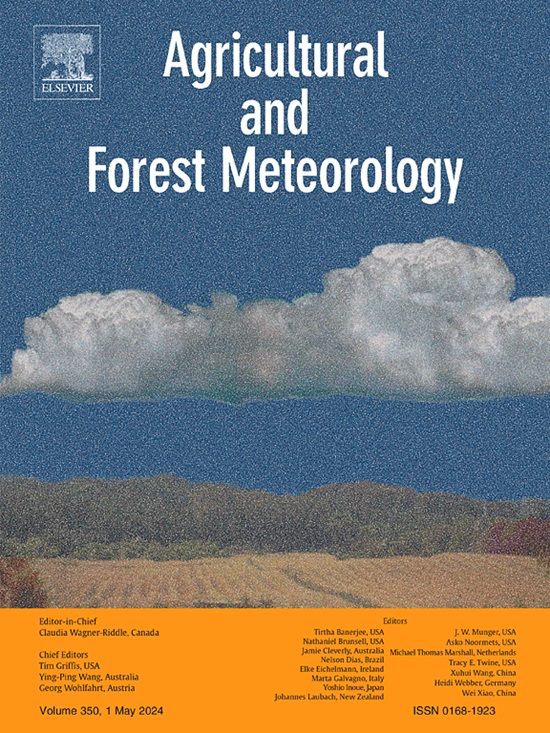Calculation of the fraction of sunlit and shaded leaf area in heterogeneous canopies with discontinuous plant crowns
IF 5.7
1区 农林科学
Q1 AGRONOMY
引用次数: 0
Abstract
The fraction of sunlit leaf area, , is a critical parameter for simple scaling of plant biophysical models from leaf to canopy, and is a useful bulk parameter describing interactions between canopy structure and function. Because of the highly non-linear response of many plant biophysical processes (e.g., photosynthesis) to light, using canopy-averaged light fluxes as the basis for scaling calculations does not yield correct whole-canopy fluxes. Accurate scaling requires calculation of the fraction of sunlit and shaded leaf area, the equations for which have been available in the literature for many decades for homogeneous canopies. However, when canopies become heterogeneous, such as in the case of many agricultural crops, the assumptions inherent in traditional approaches for estimating are violated. In this work, a simple geometric model for the sunlit leaf area fraction in discontinuous canopies is presented and evaluated against a detailed 3D leaf-resolving model for simplified plant geometries and realistic tree reconstructions derived from LiDAR data. Results illustrated that the proposed model closely matched the 3D model. An alternative definition of is presented and evaluated that can be easily applied within any model that calculates the fraction of canopy absorbed radiation, which was shown to produce values that were nearly identical to the 3D model even in the presence of foliage clumping and woody branch elements.
冠状不连续非均质冠层日照和遮蔽叶面积比例的计算
日照叶面积分数(fsun)是植物生物物理模型从叶片到冠层的简单缩放的关键参数,也是描述冠层结构与功能之间相互作用的有用体积参数。由于许多植物生物物理过程(如光合作用)对光的高度非线性响应,使用冠层平均光通量作为尺度计算的基础不能得到正确的全冠层通量。精确的标度需要计算阳光照射和遮荫叶面积的比例,其方程已经在文献中为均匀冠层提供了几十年。然而,当冠层变得异质时,例如在许多农作物的情况下,传统估算太阳的方法所固有的假设就被打破了。在这项工作中,提出了一个不连续冠层中阳光照射下叶面积分数的简单几何模型,并根据基于激光雷达数据的简化植物几何和真实树木重建的详细3D叶片分辨模型进行了评估。结果表明,该模型与三维模型吻合较好。提出并评估了fsun的另一种定义,该定义可以很容易地应用于任何计算冠层吸收辐射分数的模型中,即使在存在树叶团块和木本分支元素的情况下,也显示出与3D模型几乎相同的fsun值。
本文章由计算机程序翻译,如有差异,请以英文原文为准。
求助全文
约1分钟内获得全文
求助全文
来源期刊
CiteScore
10.30
自引率
9.70%
发文量
415
审稿时长
69 days
期刊介绍:
Agricultural and Forest Meteorology is an international journal for the publication of original articles and reviews on the inter-relationship between meteorology, agriculture, forestry, and natural ecosystems. Emphasis is on basic and applied scientific research relevant to practical problems in the field of plant and soil sciences, ecology and biogeochemistry as affected by weather as well as climate variability and change. Theoretical models should be tested against experimental data. Articles must appeal to an international audience. Special issues devoted to single topics are also published.
Typical topics include canopy micrometeorology (e.g. canopy radiation transfer, turbulence near the ground, evapotranspiration, energy balance, fluxes of trace gases), micrometeorological instrumentation (e.g., sensors for trace gases, flux measurement instruments, radiation measurement techniques), aerobiology (e.g. the dispersion of pollen, spores, insects and pesticides), biometeorology (e.g. the effect of weather and climate on plant distribution, crop yield, water-use efficiency, and plant phenology), forest-fire/weather interactions, and feedbacks from vegetation to weather and the climate system.

 求助内容:
求助内容: 应助结果提醒方式:
应助结果提醒方式:


